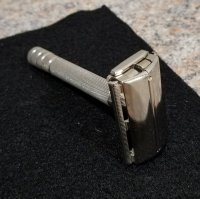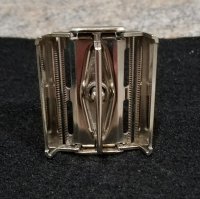- Thread starter
- #721
Eric; Thank you so much! I have more to say on historical matters, as they are certainly enmeshed into this portion of the Super Speed saga. Hopefully you will find your father's razor- mine was in a box with some of our Scouting and boyhood things, and when our childhood home was cleaned out following my mothers passing last September- I found his undated Atra, likely a promotional razor. Below are photographs taken by Cap during the disassembly and restoration of my W3 white tip, Black Tip Super Speed. The head is attached to the handle ferrule, which is the uppermost smooth and rounded portion of the handle and is separate from the handle shaft. Prior to mating the ferrule to the razor blade bed or head, the smaller diameter ferrule end would insert into the hole found at the center of the bade bed in the handle recess. The end of the ferrule was crimped over to secure the head in place to the ferrule. In 1947 to the last of the 1949 production- the crimped over ferrule end was flattened against the blade bed, producing a smooth ring as one looks down onto the blade bed and where the TTO knob center rod exits the head. At the tail-end of the 1949 production in the undated fourth quarter- this crimping was changed to a rolled or peened over style. This is done on an anvil or die which actually rolls the edge of the upper ferrule, and thus the rounded joint is peened to the razor head. apparently Gillette chose this head mating process due to assembly speed constraints, as by 1950, there was a worldwide market increase for their products.
Mike; I was more than fortunate to acquire this banjo as it quite literally fell into my lap. Jim had acquired the original banjo complete with case, and it was virtually un-played and the leather on the case was totally intact as to the care this banjo had received in period. Jim disassembled the banjo, and the neck was sent to Frank Neat in Russell Springs, Kentucky for replication to Gibson prewar standards, but widened to accept a fifth string peg. Side by side they are identical except for this feature, and the original Grover Patent pegs are used on the conversion. A flat head tone ring was made by Eric Sullivan to fit exactly to the original, and it required no modification whatsoever. The Gibson warranty decal is the best I have ever seen. I have the original arch top tone ring and hide head, which is still white and unblemished. The banjo has been authenticated and is totally original. It retains its Grover Patent tailpiece, which were often replaced for the later clamshell style. The grease painted serial number or batch number 8823-80 is present as is the red painted serial number on the inside of the maple resonator. The flange is cast brass, and makes for a stronger construction. I personally thought that it improved the tone, as this example sounded better than the two 1930 banjos we could also purchase with a pot metal flange. The pot metal flange was what Earl Scruggs had on his Pre-War Gibson, and for collectors and for that reason- slightly more expensive. I was the first to see the banjo completed aside from Jim Mills, as he had completed it earlier that week. The other two 1930 TB4's had Hearts and Flowers inlay and Flying Eagle inlay not original to the donor neck. he was kind enough to give me an original 1927 bracket wrench that was as new- perhaps the one that came with this very TB-3.


 God Bless! Tony Brown RN mgbbrown
God Bless! Tony Brown RN mgbbrown
Mike; I was more than fortunate to acquire this banjo as it quite literally fell into my lap. Jim had acquired the original banjo complete with case, and it was virtually un-played and the leather on the case was totally intact as to the care this banjo had received in period. Jim disassembled the banjo, and the neck was sent to Frank Neat in Russell Springs, Kentucky for replication to Gibson prewar standards, but widened to accept a fifth string peg. Side by side they are identical except for this feature, and the original Grover Patent pegs are used on the conversion. A flat head tone ring was made by Eric Sullivan to fit exactly to the original, and it required no modification whatsoever. The Gibson warranty decal is the best I have ever seen. I have the original arch top tone ring and hide head, which is still white and unblemished. The banjo has been authenticated and is totally original. It retains its Grover Patent tailpiece, which were often replaced for the later clamshell style. The grease painted serial number or batch number 8823-80 is present as is the red painted serial number on the inside of the maple resonator. The flange is cast brass, and makes for a stronger construction. I personally thought that it improved the tone, as this example sounded better than the two 1930 banjos we could also purchase with a pot metal flange. The pot metal flange was what Earl Scruggs had on his Pre-War Gibson, and for collectors and for that reason- slightly more expensive. I was the first to see the banjo completed aside from Jim Mills, as he had completed it earlier that week. The other two 1930 TB4's had Hearts and Flowers inlay and Flying Eagle inlay not original to the donor neck. he was kind enough to give me an original 1927 bracket wrench that was as new- perhaps the one that came with this very TB-3.





